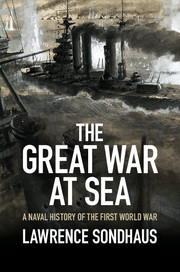Book contents
- Frontmatter
- Contents
- List of figures
- List of maps
- Acknowledgments
- Introduction
- 1 Ambition, ideology, and arms races
- 2 Preparing for war
- 3 Global prelude
- 4 European waters, 1914–15
- 5 Submarine warfare: The great experiment, 1915
- 6 Combined operations, 1915
- 7 The year of Jutland: Germany’s fleet sorties, 1916
- 8 Submarine warfare: The great gamble, 1917–18
- 9 War and revolution, 1917
- 10 Final operations
- Conclusion: Peace and naval disarmament
- Bibliography
- Index
- References
4 - European waters, 1914–15
Published online by Cambridge University Press: 05 August 2014
- Frontmatter
- Contents
- List of figures
- List of maps
- Acknowledgments
- Introduction
- 1 Ambition, ideology, and arms races
- 2 Preparing for war
- 3 Global prelude
- 4 European waters, 1914–15
- 5 Submarine warfare: The great experiment, 1915
- 6 Combined operations, 1915
- 7 The year of Jutland: Germany’s fleet sorties, 1916
- 8 Submarine warfare: The great gamble, 1917–18
- 9 War and revolution, 1917
- 10 Final operations
- Conclusion: Peace and naval disarmament
- Bibliography
- Index
- References
Summary
While the search for Spee’s squadron and individual commerce-raiding cruisers provided a focal point for the global prelude of the naval war, the battle cruiser Goeben and its escort Breslau, the only other German warships stationed beyond the Baltic and North Sea, became the dramatic centerpiece of the opening of the war in European waters. Following the lead of Winston Churchill, author of the first (and best-selling) history to address the flight of the Goeben from the central Mediterranean to the sanctuary of Constantinople, a century later historians continue to exaggerate its significance. Especially in the English-speaking world, it remains not uncommon to see this lone ship credited with bringing the Ottoman Empire into the war. The alliance of the Turks with the Germans certainly had far-reaching consequences. It blocked the Dardanelles and Bosporus to Allied shipping, cutting Russia’s best supply route from the western Allies, thereby contributing to its collapse in 1917. Meanwhile, in the Middle East, it prompted Britain to seek friends among the Arabs while also promising Palestine to the Zionists, all in the quest to undermine Ottoman rule. But in attributing the German–Ottoman alliance to the Goeben alone, some writers go as far as to postulate a causal link between its opening maneuvers and the establishment of Soviet communism, as well as the modern-day Arab–Israeli conflict, as if these world-changing developments would not have occurred otherwise. Yet Churchill himself foreshadowed such fanciful arguments by concluding that the Goeben steamed for Constantinople “carrying with her for the peoples of the East and Middle East more slaughter, more misery, and more ruin than has ever before been borne within the compass of a ship.”
- Type
- Chapter
- Information
- The Great War at SeaA Naval History of the First World War, pp. 94 - 135Publisher: Cambridge University PressPrint publication year: 2014



